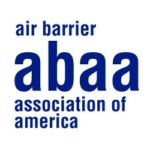Air and Water-Resistive Barrier Material Test Requirements for ABAA Listing
For a material to be listed on the ABAA website, the manufacturer shall complete the evaluation criteria process outlined in the ABAA Process for Approval of Air and Water-Resistive Barrier Materials and Assemblies document. Once a manufacturer has demonstrated to ABAA that their material meets the established criteria and has completed the process of submitting test reports and supporting documents for their material, they will be listed in the tables below as an “ABAA Evaluated Air and Water-Resistive Barrier Material” and included in the ABAA Air and Water-Resistive Barrier Master Specifications.
Air and Water-Resistive Barrier Materials have product-specific test properties that the material has to meet to ensure they will meet rigors encountered during their service life and under the buildings-imposed loads.
- Self-Adhered Sheet Membrane, Bitumen Based Air and Water-Resistive Barriers are tested for Air Leakage Rate – Material, Air Leakage Rate – Fastener, Elongation, Freeze Thaw Resistance, Fungi Resistance, Gap Bridging Ability, Lap Adhesion, Low Temperature Flexibility, Peel Adhesion (180 degrees), Pull Adhesion, Resistance to Puncture, Surface Burning Characteristics – Flame Spread Index and Smoke Development Index, Tear Initiation, Volatile Organic Compounds, Water Resistance – Hydrostatic Head Test, Water Resistance in 100% Relative Humidity, Hygroscopic Sorption Isotherms – Equilibrium Moisture Content by Weight and Water Vapor Transmission Rate.
- Fluid Applied Membrane Air and Water-Resistive Barriers are tested for Air Leakage Rate – Material, Air Leakage Rate – Material, Alkali Resistance, Elongation, Freeze Thaw Resistance, Fungi Resistance, Gap Bridging Ability, Low Temperature Flexibility, Peel Adhesion (180 degrees), Pull Adhesion, Surface Burning Characteristics – Flame Spread and Smoke Development Index, Volatile Organic Compounds, Water Absorption by Diffusion, Water-Resistance in 100% Relative Humidity and Water Vapor Transmission Rate.
- Medium Density Closed Cell Rigid Spray Polyurethane Foam (SPF) Air and Water Resistive Barriers are tested for Air Permeance, Apparent Core Density, Compressive Strength, Dimensional Stability, Fungi Resistance, Gap Bridging, Open-Cell Content Volume, Pull Adhesion, Surface Burning Characteristics, Tensile Strength, Thermal Resistance, Water Absorption, Water Resistance and Water Vapor Transmission Rate.
Gain a competitive edge over non-evaluated manufacturers. ABAA manufacturers are viewed as the manufacturers of choice for air and water-resistive barrier materials and assemblies. Manufacturers with Evaluated Materials are included in the ABAA specifications, which results in an increase in sales and greater market exposure, along with the ability to play on a level playing field with other manufacturers.
Download all documents and respective product category.
These documents will provide you with all the information needed to get the evaluation process started.
DOCUMENTS |
|
|---|---|
| Membership Application Form | Join |
| ABAA Material Evaluation Application Form for Air and Water-Resistive Barrier Materials & Assemblies | Download |
| ABAA Standard Process for Evaluation of Air, Water-Resistive and Air/Water-Resistive Barrier Materials | Download |
| Mutual Nondisclosure Agreement | Download |
| Manufacturer Licensing Agreement | Download |
PRODUCT CATEGORY
|
|
|---|---|
| Standard for Air and Water-Resistive Barriers – Fluid Applied Membrane – Material Specification | Download |
| Standard for Air and Water-Resistive Barriers – Medium Density Closed Cell Rigid Spray Polyurethane Foam – Material Specification | Download |
| Standard for Air and Water-Resistive Barriers – Self-Adhered Sheet Membrane, Bitumen Based – Material Specification | Download |
| Standard for Air Barrier Material – Mechanically Fastened Engineered Polymer Film – Material Specification | Download |
| Standard for Air Barriers – Low-Density Open-Cell Semi-Rigid Spray-Applied Polyurethane Foam – Material Specification | Download |
